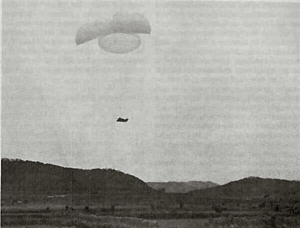Battle of Yongju
| Battle of Yongju | |||||||
|---|---|---|---|---|---|---|---|
| Part of the Korean War | |||||||
 US artillery being airdropped near Sukchon, North Korea. |
|||||||
|
|||||||
| Belligerents | |||||||
|
|
|||||||
| Commanders and leaders | |||||||
|
|
|
||||||
| Units involved | |||||||
|
|
|||||||
| Strength | |||||||
| ~ 3,000 men | ~ 2,500 men | ||||||
| Casualties and losses | |||||||
|
United States: 49 killed 136 wounded or injured Australia: 7 wounded |
1,075 killed 1,200+ captured |
||||||
![]() US 187 Airborne RCT
US 187 Airborne RCT![]() 27th Brit Com Bde
27th Brit Com Bde
The Battle of Yongju (21–22 October 1950), also known as the Battle of the Apple Orchard, took place as part of the United Nations (UN) offensive towards the Yalu River, against the North Korean forces which had invaded South Korea during the Korean War. The battle was fought between the 27th British Commonwealth Brigade and the North Korean 239th Regiment which was encircled east of Yongju, where it was attacking the US 187th Airborne Regimental Combat Team (US 187 RCT). On 20 October US 187 RCT had parachuted ahead of the advancing UN spearheads into drop zones in Sukchon and Sunchon, 40 kilometres (25 mi) north of the capital Pyongyang, with the objectives of cutting off the retreating North Korean forces that were withdrawing up the west coast of the Korean Peninsula and releasing American and South Korean prisoners of war. Although the airborne drop itself was a success, the operation came too late to intercept any significant North Korean elements and the American landings initially met little resistance. However, on 21 October as US 187 RCT began to advance south to the clear the Sukchon to Yongju road towards Pyongyang the Americans came under heavy attack from the North Korean 239th Regiment, and requested assistance.
...
Wikipedia
